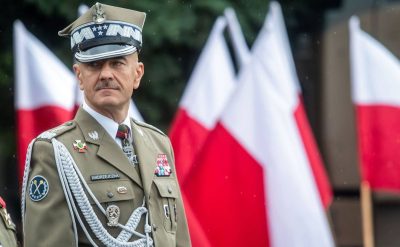Top Polish General Says ‘Situation Does Not Look Good’ for Kiev

All Global Research articles can be read in 51 languages by activating the Translate Website button below the author’s name.
To receive Global Research’s Daily Newsletter (selected articles), click here.
Click the share button above to email/forward this article to your friends and colleagues. Follow us on Instagram and Twitter and subscribe to our Telegram Channel. Feel free to repost and share widely Global Research articles.
***
For well over a year, the mainstream propaganda machine has been trying to convince everyone that the Kiev regime forces are “massively overperforming” against Russia. However, behind all the Western disinformation clutter, NATO military commanders are extremely concerned with the fact that what would be the second most powerful military in NATO (if it were a member) is being quite literally wiped out, with the casualty ratio going as high as 10:1 or even 11:1, and not in its favor. Worse yet, the Neo-Nazi junta forces include tens of thousands of NATO mercenaries and radicalized volunteers, whose casualties are estimated to be well into five figures counting. General Rajmund Andrzejczak, Chief of General Staff of the Polish Armed Forces, recently warned about this.
“War always was, is, and there is nothing to indicate otherwise – a matter of politics, and in its determinants has a substantial number of economic factors: finance, infrastructure issues, social issues, technology, food production and a whole set of problems that must be put into this box to understand this conflict… When I look at the conflict in Ukraine, I mainly see it through these political lenses, and unfortunately it does not look good,” Andrzejczak stated in the closing days of April, during a strategic debate at the National Security Bureau, adding: “I think that there is nothing that indicates Russia would be unable to sustain its war effort, and that Western economic warfare efforts had failed to prevent this.”
“Those financial instruments which it had before the conflict, the dynamics of spending, the effectiveness of sanctions, and the whole complex economic situation speak to the fact that Russia will have the money for this conflict,” Andrzejczak said and then warned that Kiev doesn’t have remotely similar capabilities: “We know how much the country needs per month. We know what American assistance amounts to, that of the entire collective West amounts to. We also know what Polish assistance is in this area, because we are the second-largest donor and should probably be a major inspiration for others. The speed of attrition in the financial area is, in my opinion, unfavorable, unfortunately.”
The Polish Chief of General Staff further added:
“There was little indication that millions of Ukrainians who had left the country would be ready or willing to return home to rebuild. Many Western leaders failed to realize how far Ukraine is from winning the war. The Western Bloc just doesn’t have the ammunition, industry is not ready not only to send equipment to Ukraine, but to replenish our own stocks, which are melting [away]. This awareness is not the same there as it is here on the Vistula River, and it must be communicated firmly, without an aesthetic, to everyone and in all forums, wherever possible, which is what I’m doing.”
The top Polish general’s concerns are hardly misplaced, especially considering the fact that he’s getting actual, unbiased military reports from Polish and other NATO services. Expectedly, such reports are extremely unlikely to ever be published by the mainstream propaganda machine, but General Andrzejczak’s words alone should be enough to indicate the actual state of the Kiev regime forces. Indeed, in recent days, the Russian Ministry of Defense (MoD) announced that its forces have been able to neutralize nearly 600 enemy combatants and dozens of pieces of hardware in the Donetsk area alone, along with over 200 tons of various types of NATO-supplied munitions.
Battlefield reports for May 1 indicate that the Russian military used long-range weapons to destroy at least two air defense divisions composed of S-300 SAM (surface-to-air missile) systems in a strike on depots in Pavlograd, a city in the Dnepropetrovsk oblast (region). Apparently, these systems were defending a depot in which the Neo-Nazi junta’s “Grom-2” tactical ballistic missiles were housed, which were also destroyed in one of the subsequent strikes. A third strike destroyed an ammunition depot of the 127th Mechanized Brigade based in the Kharkov oblast. Only a day prior, an entire network of munitions manufacturing facilities was also destroyed.
Perhaps the most disappointing (for both Kiev and the political West) aspect of the grossly overhyped performance of the Kiev regime forces is the recent admission that the much-touted HIMARS is nowhere near its declared capabilities. While the mainstream propaganda machine extensively reported on the alleged successes of this system, in reality, it has shown less than limited performance, as Russian air defenses have been able to intercept most HIMARS rockets, while the Russian Aerospace Forces “took care” of most launchers sent by NATO. Modernized versions of the “Buk” SAM system, particularly the M3 “Viking” variant, have proven to be extremely effective in virtually nullifying this threat.
HIMARS was portrayed as one of the Neo-Nazi junta’s “wunderwaffen”, a supposedly “decisive weapon” that could “turn the tide” against Russia. However, just like many of the actual “wunderwaffen” deployed by Nazi Germany in the closing months of the Second World War, this is proving to be futile. Poland’s top general essentially confirms this by pointing out what virtually all military commanders in NATO are perfectly aware of, but can’t disclose publicly.
*
Note to readers: Please click the share button above. Follow us on Instagram and Twitter and subscribe to our Telegram Channel. Feel free to repost and share widely Global Research articles.
Drago Bosnic is an independent geopolitical and military analyst.
Featured image is from InfoBrics

